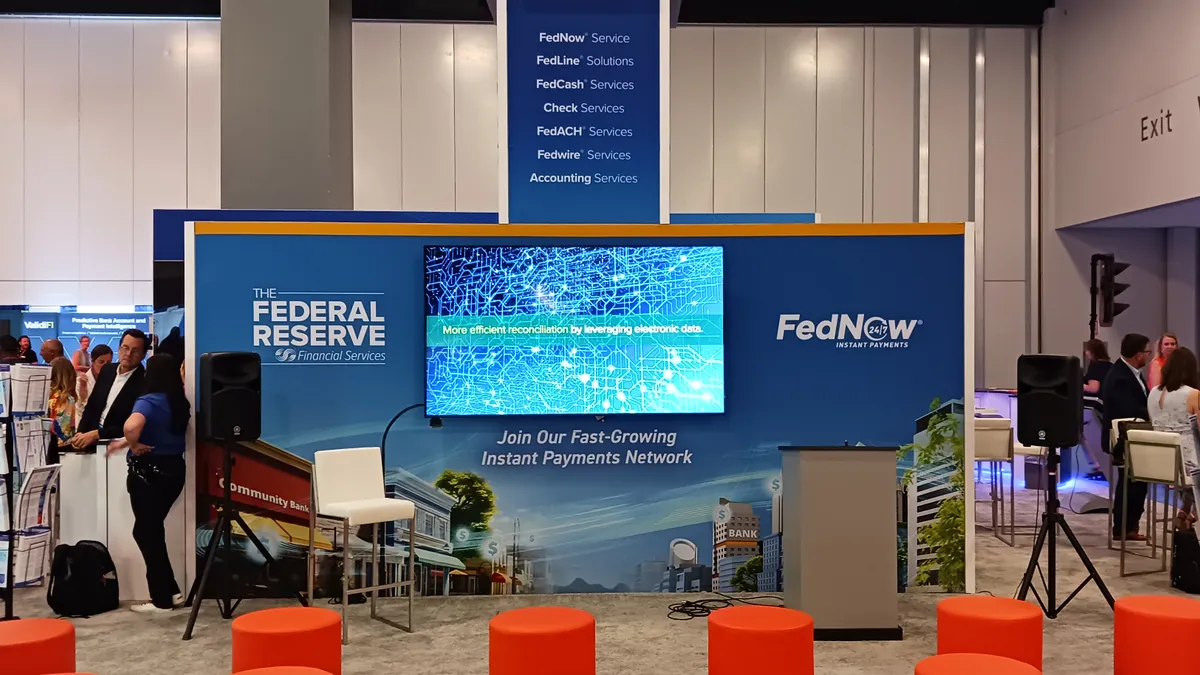The Federal Reserve aims to make its instant payments system FedNow an everyday utility in the U.S. financial services sphere, offered by every bank, Financial Services’ chief payments executive, Mark Gould, told attendees at a major industry conference last week.
“It's going to be up to us to move instant payments from being novel to being normal,” Gould said during a discussion on “the rise of instant payments” with Modern Treasury CEO Dimitri Dadiomov at the Money 20/20 conference on Oct. 27.
He likened the situation to telephone landlines being common ten years ago, but noted how today very few people in the audience probably have one at home. He said he didn’t know when real-time payments will be one of those types of commonplace services, but predicted they will be at some point.
The Fed, which launched the FedNow instant payments system in July 2023, is seeking to have every bank and credit union in the country adopt the new service, Gould said.
“The important thing, that I would just emphasize, is that our goal was never to have 35, or 1,000” financial institutions connected to FedNow, Gould said at the conference. “Our goal is for every financial institution to be connected. We want instant payments to be ubiquitously available and broadly used for a wide variety of applications around the country.”
That’s a bit different from comments earlier this year from another Fed official, FedNow’s head of payments product, Dan Baum, who said the Fed was shooting to attract between 7,000 and 8,000 financial institutions to the system.
Given the banking industry consolidation trend, the two outlooks could end up being one in the same as the number of financial institutions in the U.S. declines. Of course, it will also depend on the speed with which FedNow is adopted by the institutions.
So far, only about 1,000 of the approximately 9,100 U.S. financial institutions have connected to FedNow. Even some of the biggest banks in the country haven’t signed up for the system.
It was the smaller financial institutions that were particularly eager to see the Fed launch FedNow because the only other real-time payment system in the country, the RTP network, is owned and operated by the biggest banks through The Clearing House. As a result, those smaller institutions were leery of participating in a system led by their larger rivals.
Still, for some smaller institutions, upgrading their technology and adjusting their staffing to accommodate a system that’s available around the clock isn’t necessarily an easy task. It may also be costly. Many have signed on just to receive FedNow payments, and have yet to turn on the functionality for sending payments, given the increased risk associated with sending.
“For (FedNow) to fully reach its potential, we need every financial institution connected,” Gould said at the conference. “We need businesses of all shapes and sizes to think about the opportunities that instant payments present and ultimately transform how payments are made.”
While the Fed’s initial focus has been on educating financial institutions about how to adopt and use the FedNow system, Gould said the next Fed campaign will be on better educating businesses about how instant payments may be valuable to them. With both, he expects that fear of missing out will drive further adoption.
“My own personal view is that FOMO is going to drive not just adoption, but usage of instant payments over time, because everybody's going to be trying to provide the best services possible,” Gould said.
So far, FedNow’s instant payment capabilities have been particularly well-suited to certain use cases, specifically early access wage services wherein some companies give employees access to their pay before regularly scheduled paydays, Gould noted.
He expects such instant payments will increasingly be useful for insurance settlements, such as funds that may be needed quickly after disastrous storms. He also explained how instant payments are likely to eventually be common for situations like making a payment to buy a car on the weekend.
“I think 10 years from now, we will look back and say, ‘remember when you couldn't buy a car on the weekend, and it had to settle over over several days?’” Gould explained. “We're going to get to a point with adoption of instant payments that it not just transforms how payments are made, but it transforms how people are doing business.”
Correction: This story has been updated to correct the approximate number of U.S. financial institutions.










